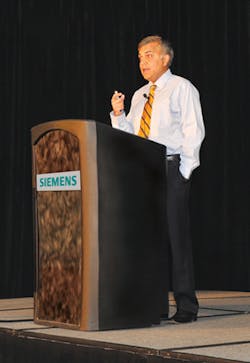Sustainability, Energy Efficiency Emphasized at Siemens Event
“Sustainability has really become the fabric of our businesses,” Raj Batra told an audience of automation professionals during an opening day keynote at the at the 2010 Siemens Automation Summit, held June 8-10 in Charlotte, N.C. “And it’s not just about feel-good marketing programs,” said Batra, who is president, Siemens Industry Automation Division (www.usa.siemens.com), based in Norcross, Ga. Rather, Batra noted, “it’s really about redefining a new paradigm for manufacturing, and finding better ways to do things and to drive money to the bottom line with measures around sustainability.”
During the keynote and in subsequent interviews with Automation World, Batra cited various “macro trends” that he said “are having a very profound impact on what’s happening in manufacturing in the United States.” Besides sustainability, the list includes the related fields of energy efficiency and the Smart Grid, along with a drive to more tightly integrate all phases of the manufacturing process, from product and production design to delivery and disposal.
Not surprisingly, perhaps, Batra noted that Siemens has solutions for manufacturing customers in all of these realms. “We have the largest portfolio of green products globally,” he said, adding that Siemens’ green portfolio products account for about $32 billion in business for the company.
This year’s Siemens Automation Summit drew around 190 attendees, comparable to that of earlier years, said conference sources, while the co-located Answers for Industry Conference—offered at no charge to Siemens users—attracted nearly 800. Around 100 of those totals were said to be Siemens employees. The 2010 version of the Automation Summit followed a 2009 in which regional events replaced a central, national conference, in deference to last year’s difficult economic conditions.
Recovering economy
According to Batra, however, the worst of the downturn now appears to be over. “We’re starting to see the early signs of recovery, and I think by all indications, the recession is coming to a close, even though employment doesn’t always reflect that,” he said during a podcast interview with Automation World. The Institute of Supply Management’s PMI (for Purchasing Managers’ Index), “the king of manufacturing indices,” recently marked its 10th consecutive month of expansion, Batra pointed out. Industries including discrete manufacturing and machinery segments “are starting to show dramatic improvement,” he added. As a result, in terms of order rates, “we’re probably 15 percent ahead of where we originally planned to be when we started the year.”
To hear a podcast interview with Siemens’ Raj Batra, visit
www.automationworld.com/podcast-7192.
One major focus of industry today is energy efficiency. “Sixty percent of all energy consumption is driven by industrial use,” said Batra. So individual Siemens product technologies, ranging from high efficiency motors to complex facility management and control systems are important to help companies drive efficiencies, he said.
As one instance of how a simple product innovation can help customers boost energy efficiency, Batra cited an example from the Profibus suite of network protocols championed by Siemens. Profienergy, an extension of the Profinet real-time industrial Ethernet protocol, was introduced by Profibus International last year.
Production lines left idle during breaks and weekends can consume up to 60 percent of the energy used during full production. But with the Profinet topology, Profienergy can be used to automatically trigger standby, sleep mode, power down and wake up, all from a central location, Batra noted. By using Profienergy, Mercedes Benz has achieved a 75 percent reduction in energy costs during nonproductive periods, he said. “That’s money that goes right to the bottom line, just with a simple innovation in protocol.”
Integrated whole
On the sustainable manufacturing front, Siemens’ 2007 acquisition of UGS Corp., a product lifecycle management software supplier, is paying dividends by enabling customers to look at product design, production and supply chains as an integrated whole, said Batra. So-called “digital manufacturing” based on visualization, or virtualization, during the design of both products and production processes is becoming more commonly used, he said. Some 75 percent of manufacturing costs are predetermined in the product design phase, according to Batra. So gaining efficiencies during this phase is “an important critical step for sustainable manufacturing,” whether the gain results in “fewer parts on a jet or less plastic consumed in a bottle,” Batra concluded.
About the Author
Wes Iversen
Managing Editor

Leaders relevant to this article:
